Decorative boxes are often of great sentimental value, passed down as heirlooms or given as gifts. Many will protect precious items, serving as jewelry or memory boxes, or may themselves be of great value in the antiques market.
An antique box which is smaller than a traditional chest is often known as a casket. These come in all shapes and sizes, with a variety of decorative forms and genres. Treasure chests can fit into the realm of furniture restoration, but when they are detailed and decorated they may also require similar preservation skills.
Whether a box or chest is of personal or monetary worth, it may require conservation treatment to avoid deterioration and eventual decay. Decorative boxes often include various materials, including wood, metals, ivory, precious stones, paint, leather and lacquer, all of which need tailored care.
 Above: a selection of antique wooden boxes with different detailing and decoration
Above: a selection of antique wooden boxes with different detailing and decoration
The types of boxes our team can restore include, but are not limited to, trinket boxes, jewellery boxes, chests, memory boxes, dowry chests, and caskets of varying materials.
This article will cover some of the unique and interesting varieties of antique boxes, including those which our team have worked on at Fine Art Restoration company. We will also outline care for specific materials, so that they may be properly protected at home.
The value and style of antique boxes
Whilst we may associate historic chests with treasure seeking adventurers, they were often used as side tables or home storage. In some cultures these were also used to hold a wedding dowry, housing all of the possessions a young girl would take with her into married life. The remaining box, which was often decorated by hand, would be an important family heirloom. These folk art pieces are also known as ‘hope chests’ and can sell for several thousand pounds depending on their condition.
 Above: a yellow pine European/American hope chest from the 18th or 19th century
Above: a yellow pine European/American hope chest from the 18th or 19th century
Like many forms of decorative accessories, caskets and chests can be dated back to ancient history. Due to the longevity of their hard materials, detailed examples from early Christian art include the Brescia Casket from the 4th century and the Franks Casket from the 8th century, which were carved in ivory and whalebone. In May 2021, a 14th century ivory casket sold for close to £1.5 million. However, many historic boxes were created from timber, with aspects of leather and precious metals.
 Above: a detail from an ivory casket featuring scenes from Arthurian legends, 1310-1330
Above: a detail from an ivory casket featuring scenes from Arthurian legends, 1310-1330
Throughout history, royalty and the aristocracy had storage especially created for collections of jewels. Whilst ‘jewel cabinets’ such as those commissioned by Marie Antoinette are vast and extravagant, and more akin to a piece of furniture, jewelry boxes for a more modest collection became popular from the 19th century onwards. Victorian jewellery boxes can sell from anywhere between £145 to £8,000 and are often wooden with some embellishments in paintwork, marquetry, or metals.
 Above: bejeweled snuff boxes which may have been later used as trinket boxes
Above: bejeweled snuff boxes which may have been later used as trinket boxes
In more recent decades, such boxes are often a gift to a loved one and may house important personal artefacts or have sentimental value. Family heirlooms passed down from generation to generation may form part of a dressing table for decades. Art deco boxes remain fashionable today, as well as those from later decades which may have a particular connection to a person, place, craftsman, or designer.
Beguiling box facts
- Linley created 5 jewelry boxes uniquely shaped as replicas of Highclere Castle. Each were crafted from 10,944 pieces of marquery and sold for £65,000 each in 2013.
- In 2018 a lost portrait of Charles Dickens was discovered in a trinket box during an auction in South Africa. The miniature by Margaret Gillies had not been seen for 175 years.
- A Chinese wooden trinket box with mother of pearl inlay sold for £784,790 in 2015 at Bonhams.
- Classical trinket boxes are known as ‘pyxis’, these rare antiques can be gold, ceramic, leather, glass, or even traditional Greek pottery.
- The domed lid of a traditional chest allowed them to survive centuries due to water easily sliding away and the avoidance of people sitting or placing heavy objects on top of them.
Caring for antique boxes
As there are many different materials found in these types of boxes it is important to know how to approach each type when caring for them at home, to prevent accidental or environmental damage which can be avoided with the correct measures in place.
Wooden boxes
Like all wooden items, it is important to keep the timber subtle with an even temperature and humidity level. A dry atmosphere may lead to brittle wood, whilst high humidity causes expansion. Constant fluctuations will cause expansion and contraction, leading to warping and breakages due to the build up of pressure. If there are no painted details or extra features, you can keep the wood in good condition with the application of boiled linseed oil and turpentine. A steady humidity level of around 40-60% and a temperature of around 20 degrees celsius is recommended. You can read more about the treatment of water damaged wooden furniture here.
 Above: a hand painted chest crafted by German immigrants in Pennsylvania, 1780. Made from yellow pine and tulip poplar
Above: a hand painted chest crafted by German immigrants in Pennsylvania, 1780. Made from yellow pine and tulip poplar
Marquetry boxes
Marquetry can be easily damaged when wood is exposed to rapidly changing humidity levels and temperatures. These parts may rupture or become loose, spoiling the visual impact and in some cases the value of the antique. As mentioned above, keep the wood in an atmosphere with even levels. If pieces do break free, hold onto these as they can be reapplied by our conservators. Do not use household adhesives to try this at home, as it may lead to acidic decay. You can read more about marquetry here.
 Above: an example of a wooden box with floral marquetry decoration
Above: an example of a wooden box with floral marquetry decoration
Painted and lacquered boxes
If the wood begins to crack or distort through fluctuation, the paint layer may flake away in small or large pieces. However, this can still occur whilst the atmosphere is under control if the painting itself is naturally degrading or was not properly prepared. This may be the case with folk art pieces, which would not have been created with professional techniques or materials. To prevent paint loss, do not attempt to clean or treat these areas yourself. Unprofessional cleaning attempts may lead to abrasion and instability in the surface. A lacquered box is created with a thick and high shine shellac varnish, this may discolour over time and become cracked or scratched. To avoid worsening damage, contact our team as soon as any deterioration is spotted and avoid DIY techniques to solve the issues, as this may cause further deterioration.
 Above: a lacquered trinket box with surface damage and flaking areas, before restoration by our team
Above: a lacquered trinket box with surface damage and flaking areas, before restoration by our team
Ivory boxes
Ivory can survive for decades in the correct conditions, but may become sun bleached or brittle if the atmosphere is not correct. Dry ivory can split along its growth lines, so humidity should be kept at around 50% at all times. Almond oil is recommended to treat the piece annually, this can be brushed on and left overnight before being wiped away. Rotate the piece once a year, to ensure there are even levels of filtered light upon both sides. If any areas break off, keep these for the reapplication by our trained conservator. You can learn more about ivory here.
 Above: an ivory panel from a 10th century box featuring an intricate repeat pattern
Above: an ivory panel from a 10th century box featuring an intricate repeat pattern
Ceramic and enamel boxes
Traditional ceramics and enamel mediums have a high risk of damage from accidental knocks or falls. When a ceramic box smashes or has a clean break, make sure to collect all of the pieces for safe keeping. Do not attempt to glue these areas together with household adhesives, as this will lead to a yellowing discolouration and acidic decay. Instead, consult our team who will arrange an assessment by our specialist ceramics conservator. Seamless restorations are achievable through careful reconstruction of the broken parts. Any missing areas can be remoulded and colour-matched. When cleaning a ceramic or enamel item which has an overlay of colours or gilding, ensure that these areas are not rubbed or scratched. Use a soft dry cloth to clear away dust, avoiding the use of any chemicals. You can read more about caring for ceramics here.
 Above: a selection of ceramic boxes in common styles, including an 18th century Wedgwood box (right)
Above: a selection of ceramic boxes in common styles, including an 18th century Wedgwood box (right)
Hinges and joins
Areas of loose joins or rusting elements should be treated by a conservator, rather than household chemicals or polishes. This is due to the age of the metal elements, which may require replacement if they are severely degraded. A loose join may incur damage to the rest of the box or chest, so it is vital that this is stabilised by our professional woodwork conservator. Cease to use the box or chest for practical purposes until the hinges and joins are resecured.
Restoring trinket boxes
Our team has restored several boxes, including family heirlooms which have great sentimental importance. One of these includes a trinket box which was gifted by our client’s father in the 1960s, following a cultural trip to the USSR. The hand-painted box was likely purchased in Tbilisi; the lid features wild birds in a landscape with a lacquered finish. The inside is bright red, in contrast to the surrounding black edges. The box had become extremely scratched over time, with indents in the lacquer and paint layer from this damage. The painted area was also discoloured due to the natural yellowing of the varnish. Our conservator removed the discoloured varnish and carefully stabilised the affected areas, this includes ensuring that the paint layer is fully adhered to the surface with no risk of flaking or further visual damage.
An ivory inlaid box also came to our attention, this required dominant cracks in the surface to be strengthened, with loose or high risk areas being reapplied to the surface with conservation appropriate solutions. The piece was delicately cleaned and any missing areas were especially crafted and replaced to reduce visual disturbances. As ivory is not legal to obtain, our conservator can create these out of a substitute substance which is expertly colour-matched to avoid visual disturbances.
 Above: the lid of a hand painted Russian lacquer box before and after restoration by our team, reducing yellowing and a cracking surface
Above: the lid of a hand painted Russian lacquer box before and after restoration by our team, reducing yellowing and a cracking surface
Restoring treasure chests
If the box begins to loosen around joins, has areas of concern such as dry rot or insects, or seems to be warping, please contact our team as soon as possible for quick intervention to avoid continued damage. Accidental damage, such as water marks or stains, can also be treated and safely removed before they create widespread disturbances.
When a wooden chest or box is met with a disaster such as flooding, leaks, or a fire, our team can be on hand to help salvage it and provide professional care. The faster the piece is taken from the affected area and treated, the less the costs and level of damage will be for the restoration. Following a flood, avoid the use of industrial drying units for wood, as this fluctuation will accelerate warping in the structure. You can instead allow the piece to dry naturally in a clean environment, but it will still require professional assessment to prevent mould or rot from occurring.
 Above: a handmade dowry chest with scratched and flaking paint
Above: a handmade dowry chest with scratched and flaking paint
Contact our team for further information
If you have a chest or trinket box which may benefit from conservation treatment, please contact our team today for swift and helpful advice.
You can email us via [email protected] or call 207 112 7576.
You may also be interested in:

 Above: a selection of antique wooden boxes with different detailing and decoration
Above: a selection of antique wooden boxes with different detailing and decoration Above: a yellow pine European/American hope chest from the 18th or 19th century
Above: a yellow pine European/American hope chest from the 18th or 19th century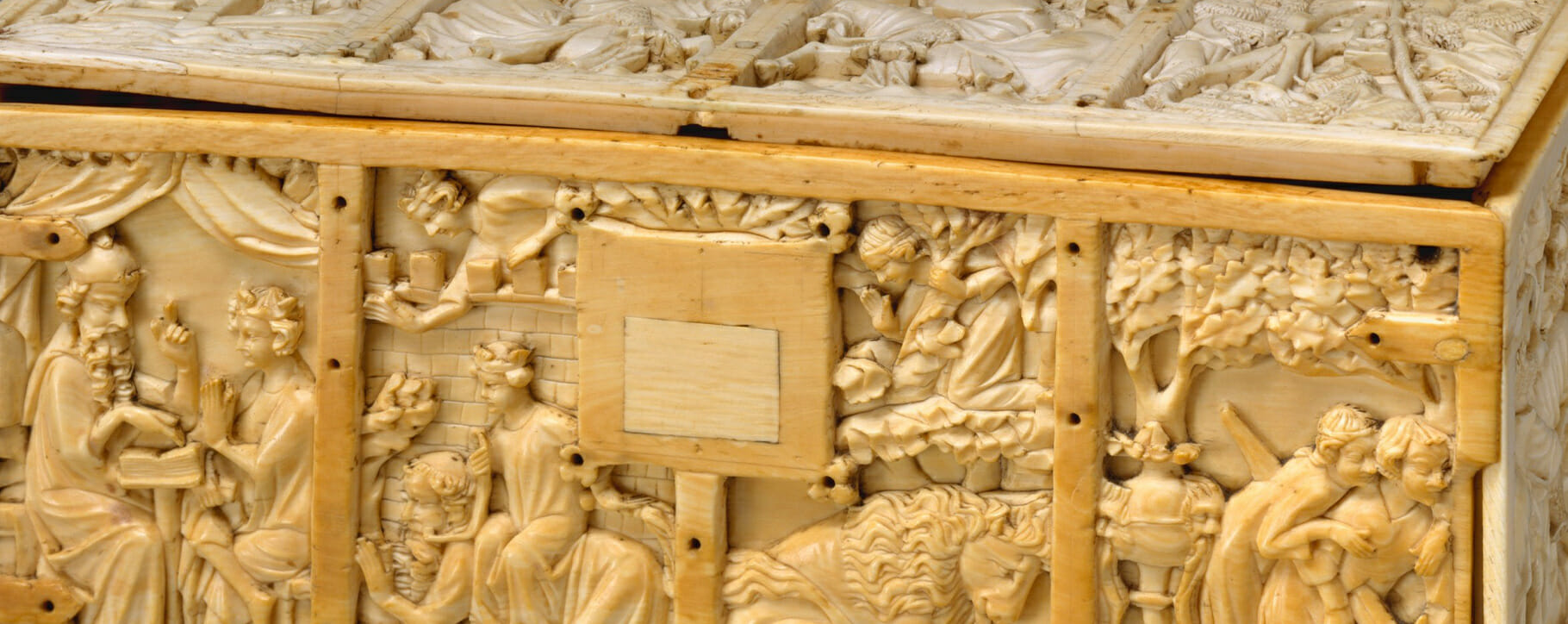 Above: a detail from an ivory casket featuring scenes from Arthurian legends, 1310-1330
Above: a detail from an ivory casket featuring scenes from Arthurian legends, 1310-1330 Above: bejeweled snuff boxes which may have been later used as trinket boxes
Above: bejeweled snuff boxes which may have been later used as trinket boxes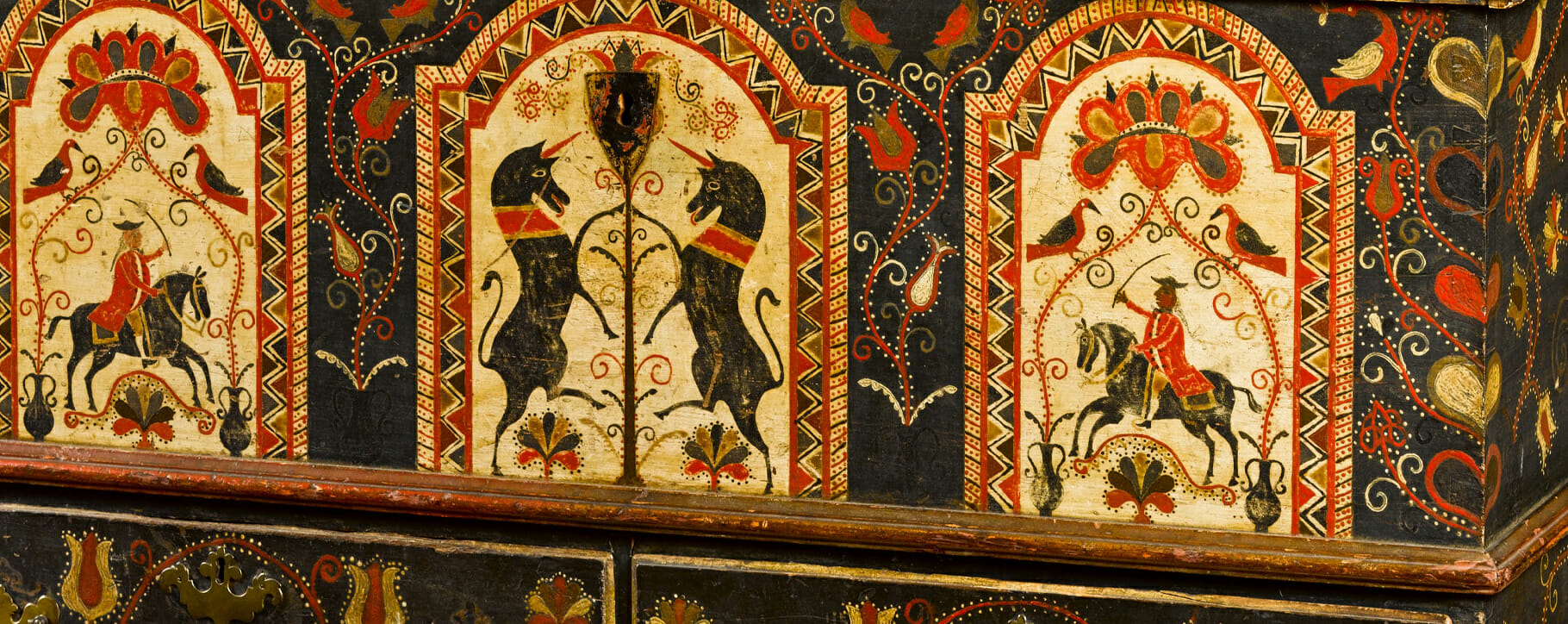 Above: a hand painted chest crafted by German immigrants in Pennsylvania, 1780. Made from yellow pine and tulip poplar
Above: a hand painted chest crafted by German immigrants in Pennsylvania, 1780. Made from yellow pine and tulip poplar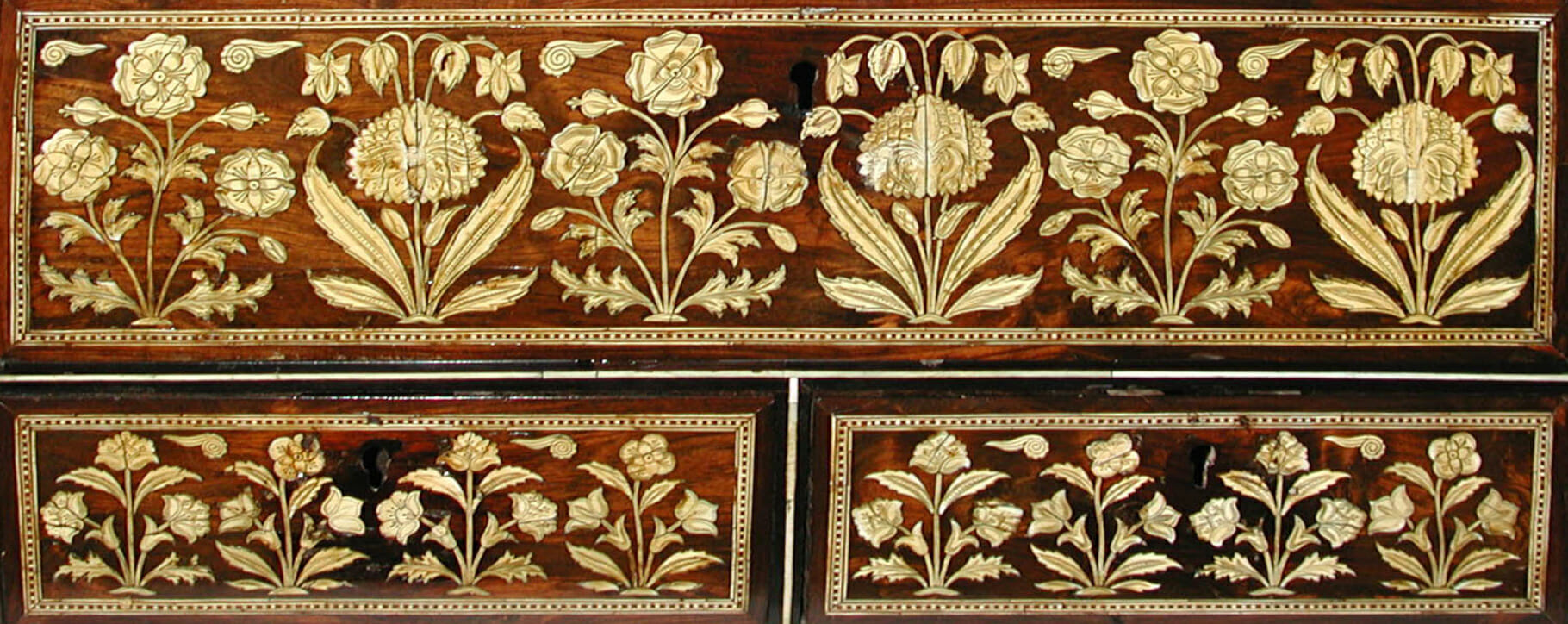 Above: an example of a wooden box with floral marquetry decoration
Above: an example of a wooden box with floral marquetry decoration Above: a lacquered trinket box with surface damage and flaking areas, before restoration by our team
Above: a lacquered trinket box with surface damage and flaking areas, before restoration by our team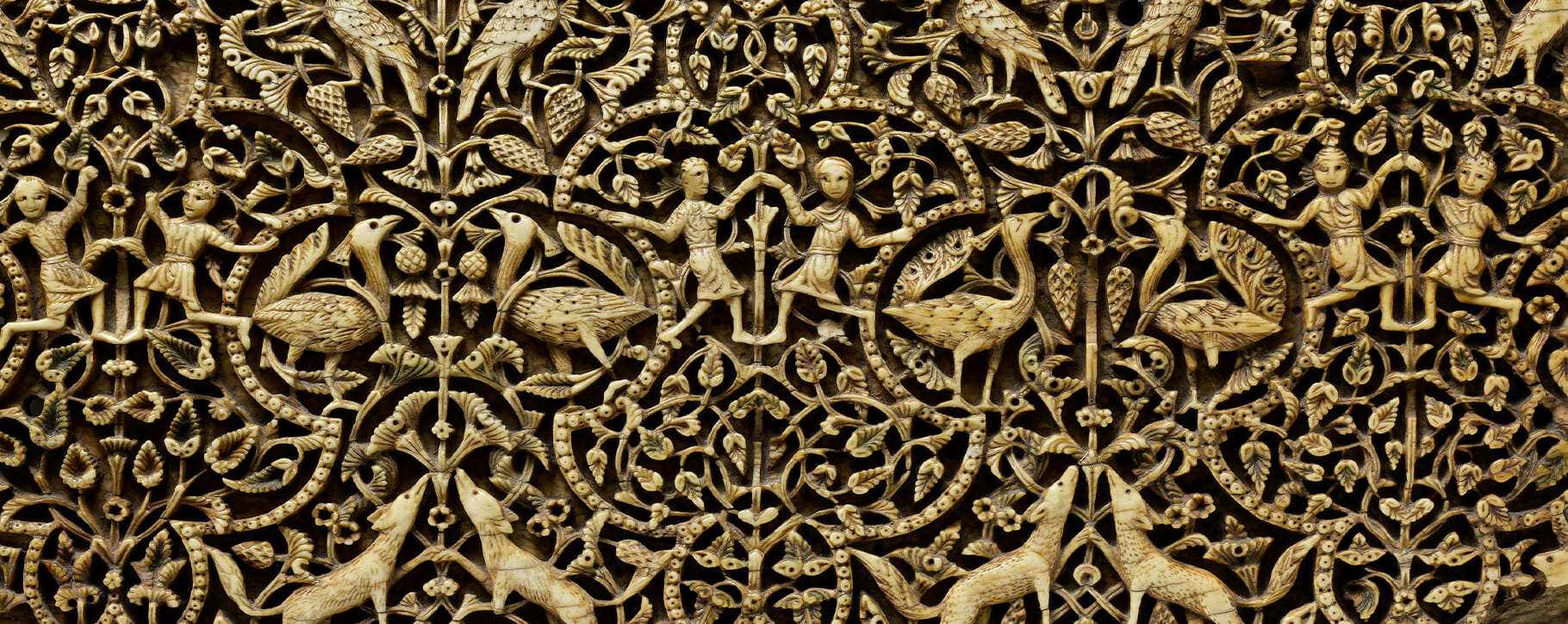 Above: an ivory panel from a 10th century box featuring an intricate repeat pattern
Above: an ivory panel from a 10th century box featuring an intricate repeat pattern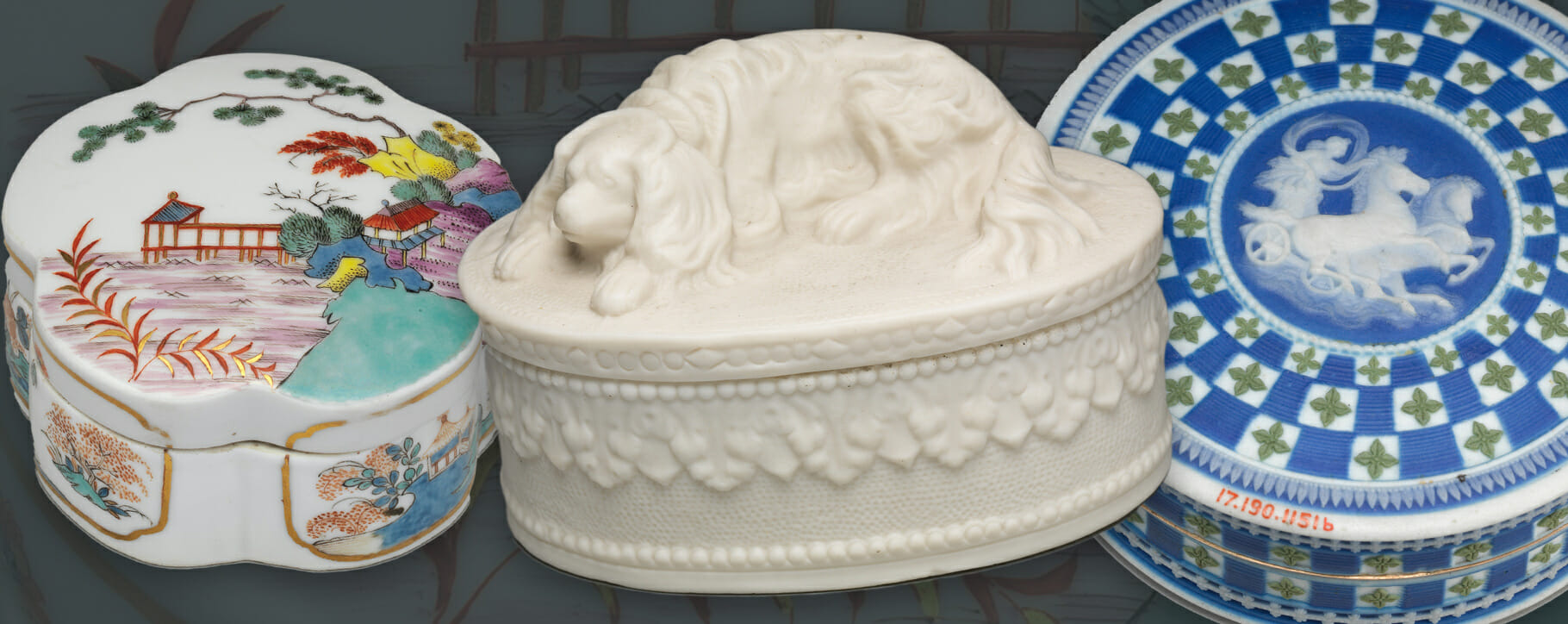 Above: a selection of ceramic boxes in common styles, including an 18th century Wedgwood box (right)
Above: a selection of ceramic boxes in common styles, including an 18th century Wedgwood box (right)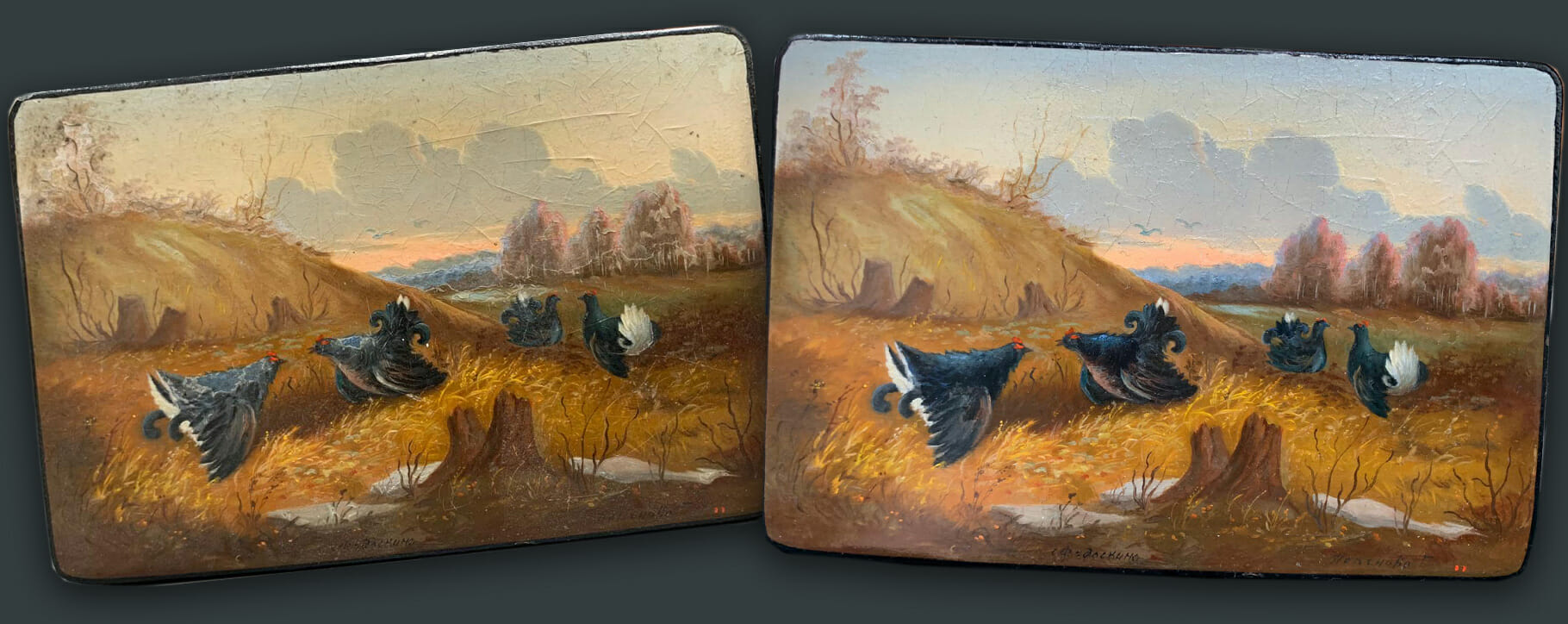 Above: the lid of a hand painted Russian lacquer box before and after restoration by our team, reducing yellowing and a cracking surface
Above: the lid of a hand painted Russian lacquer box before and after restoration by our team, reducing yellowing and a cracking surface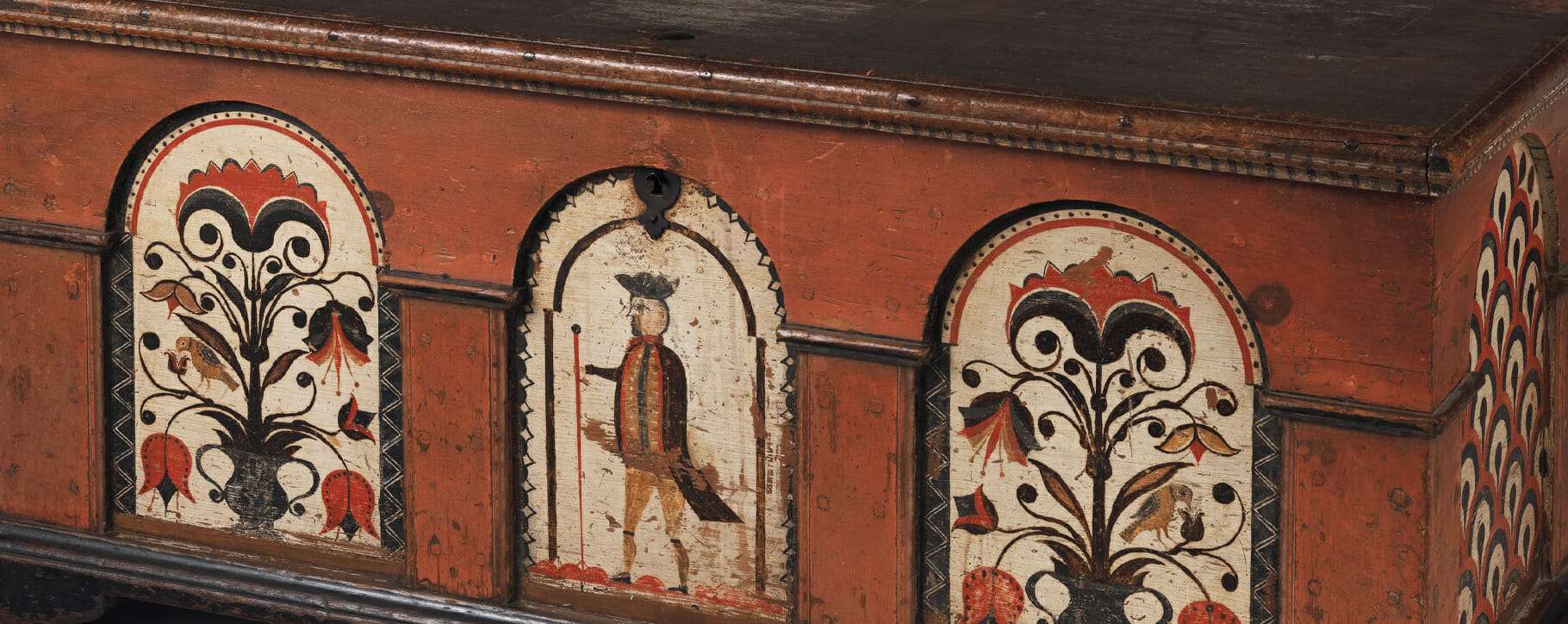 Above: a handmade dowry chest with scratched and flaking paint
Above: a handmade dowry chest with scratched and flaking paint




